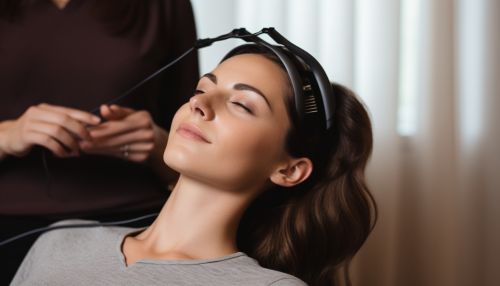Non-Invasive Brain Stimulation Techniques
Introduction
Non-invasive brain stimulation techniques are a group of methods used in neuroscience to modulate the activity of the brain without the need for surgical intervention. These techniques are used for both research and clinical purposes, and have been instrumental in advancing our understanding of brain function and treating various neurological and psychiatric disorders. This article will provide a comprehensive overview of the main non-invasive brain stimulation techniques, including their principles, applications, and potential benefits and risks.
Transcranial Magnetic Stimulation (TMS)
Transcranial Magnetic Stimulation (TMS) is a non-invasive brain stimulation technique that uses a magnetic field to induce an electric current in specific areas of the brain. The magnetic field is generated by a coil placed on the scalp, which can be targeted to stimulate specific brain regions. TMS can be used to either excite or inhibit neuronal activity, depending on the frequency and intensity of the stimulation.


TMS has been used in a wide range of research and clinical applications. In research, it can be used to study the functional organization of the brain, the role of different brain regions in cognitive processes, and the mechanisms of neural plasticity. Clinically, TMS has been approved for the treatment of major depressive disorder, and is being investigated for its potential in treating a variety of other conditions, including stroke, Parkinson's disease, and schizophrenia.
Transcranial Direct Current Stimulation (tDCS)
Transcranial Direct Current Stimulation (tDCS) is another non-invasive brain stimulation technique that uses a weak electrical current to modulate neuronal activity. The current is delivered through two electrodes placed on the scalp, creating an electrical field that can either increase or decrease neuronal excitability.
tDCS has been used in both research and clinical settings. In research, it can be used to study the effects of cortical excitability on cognitive processes, and to investigate the mechanisms of neuroplasticity. Clinically, tDCS has been explored as a potential treatment for a variety of conditions, including depression, chronic pain, and cognitive impairment.
Transcranial Alternating Current Stimulation (tACS)
Transcranial Alternating Current Stimulation (tACS) is a non-invasive brain stimulation technique that uses an alternating electrical current to modulate brain activity. The current is delivered through two or more electrodes placed on the scalp, and can be used to entrain brain oscillations, or to disrupt or enhance specific patterns of neural activity.
tACS has been used in research to study the role of brain oscillations in cognitive processes, and to investigate the mechanisms of neural synchronization and plasticity. Clinically, tACS is still in the experimental stage, but it has shown promise in preliminary studies for the treatment of conditions such as depression, epilepsy, and Parkinson's disease.
Safety and Side Effects
Non-invasive brain stimulation techniques are generally considered safe, but they can have side effects. The most common side effects are mild and transient, and include headache, scalp discomfort at the site of stimulation, and light-headedness. More serious side effects are rare, but can include seizures, mania (if you have bipolar disorder), and hearing loss if ear protection is not used during TMS.
Future Directions
Non-invasive brain stimulation techniques are a rapidly evolving field, with new methods and applications being developed continuously. Future research will likely focus on refining these techniques to improve their specificity and efficacy, developing new stimulation protocols for different conditions, and integrating non-invasive brain stimulation with other interventions, such as cognitive training and pharmacotherapy.
